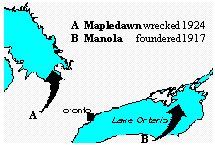

The Mapledawn can jokingly be argued to be the longest wreck dive in
the Great Lakes. The stern can be found off the west shore of Christian
Island located in the southeast corner of Georgian Bay. T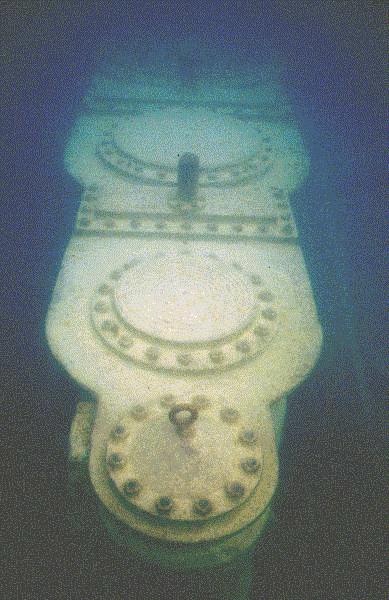 he bow is located
off Quinte in Lake Ontario 250km away - much further if you don't go over
land.
he bow is located
off Quinte in Lake Ontario 250km away - much further if you don't go over
land.
The steel freighter Mapledawn, with its massive in-line quadruple expansion engine, was originally launched as the Manola in Cleveland circa 1890. It is believed that as the Manola she was sold to overseas' interests to serve in WW1. It was required that she be cut in two for transit through the St. Lawrence, to be put back together at Montreal. However, the bow section of the Manola was lost in a storm off Quinte, putting an end to the sale. A new bow section was made, and she was reborn as the Mapledawn and launched in 1920, with a length of 350 feet. On Nov. 30, 1924 the Mapledawn was lost in a snowstorm. During the reduced visibility of the storm, this dive-site-to-be ventured too close to shore. Hitting one of the many submerged rocks in the area, a section of the stern with propeller and a portion of propeller shaft attached was snapped off, flooding the engine room almost instantly. This section lies in slightly deeper water just to the northwest of the main body of the wreck: the location of the rudder is unknown. Helpless without power or steerage and pushed by wind and waves, she was very soon hard aground. Two men made it to shore, hiked across the island to an Indian Reservation for help and all hands were saved.
As a footnote to history, one of those two men returned some weeks later and tried to recover some personal effects left on the vessel during the disaster, but drowned in the attempt.
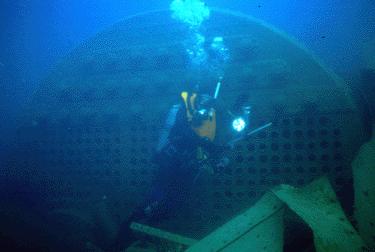
The wreck today lies upright in 15-30 feet of water 100 yards from shore, a large steel freighter in shallow water. Being on the exposed side of the island as she is, winter ice has changed her much over the years.
My first of many dives on the Mapledawn was also my very first wreck
dive, Labour Day weekend 1972. At that time, the bow section stuck out of
the water 6 to 8 feet. The first 40 ft. of the bow were as if severed by
a giant knife, rotated, then shoved open end down, the bow sprint pointing
skyward into the air. The forward mast was parallel, but about 15 feet off
the bottom. With this sign post it, was a simple matter to locate the wreck
and tie up directly to the bow. At that time, it was possible to descend
the bottom and enter the bow section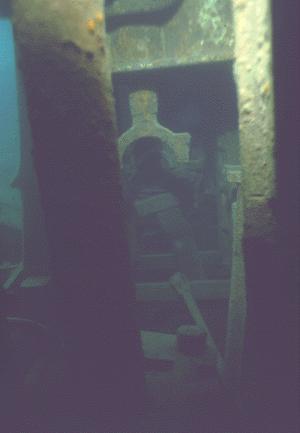 , then ascend through the decks,
past the anchor winches, eventually surfacing inside the chain locker. The
18" diameter hawse pipes open to the outside and well above the surface
of the water. Over the years, the bow section has been pounded lower and
lower by ice until it's now 10ft. below the surface, and the mast now lies
flat on the bottom. The mid-section, making up the bulk of the wreck, is
a field of flattened deck plating, some of which is inch-thick steel plates
torn as if only newspaper. Small explorable passages abound.
, then ascend through the decks,
past the anchor winches, eventually surfacing inside the chain locker. The
18" diameter hawse pipes open to the outside and well above the surface
of the water. Over the years, the bow section has been pounded lower and
lower by ice until it's now 10ft. below the surface, and the mast now lies
flat on the bottom. The mid-section, making up the bulk of the wreck, is
a field of flattened deck plating, some of which is inch-thick steel plates
torn as if only newspaper. Small explorable passages abound.
On to the stern section, which is to me the high point of the dive. Two
massive boilers, sitting intact and upright, appear ready to be fired up.
Boiler maintenance tools lie stacked on a shelf between the boilers. Adjacent
to the fire boxes sit bunkers still full of coal. Just behind the boilers,
and reaching almost to the surface 30' above, sits the upright steam engine.
So big is this engine that I can easily swim lengthwise through the connecting
rods, with the engine block above and the crankshaft below. Out of the engine
and along the drive shaft, one comes to the thrust bearing where the force
from the rotating propeller shaft was transferred to the hull. It appears
to have been water cooled when it was operating. Another ten feet and the
bottom turns from steel plate to sand. The propeller shaft ends abruptly
at a sheared- off connector plate. Both sides and ahead are open, with the
fan tail overhead. This is where the propeller section had once been attached.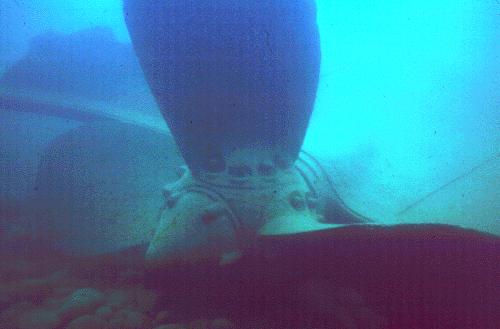
From time to time, a line is strung along the bottom to the propeller section, located apart from the wreck in slightly deeper water, the evidence of how a commercial transport became one of the top Ontario dive sites. If the line isn't present, swim at about a 45 degree angle to the left, as the line of the wreck is behind you. Go over a hill of gravel and vis permitting (which it usually does), you should see the propeller section in about 35'.
Article and Photos by Clifford Sumbler
Photo's are Copyright © of the photographer.